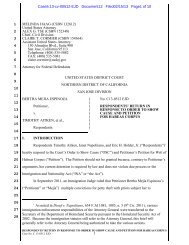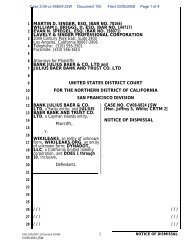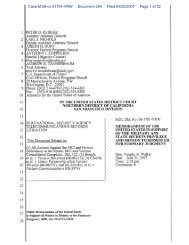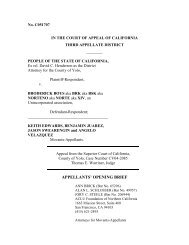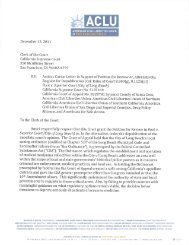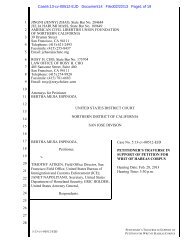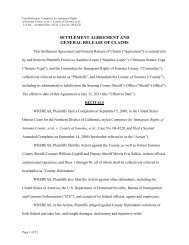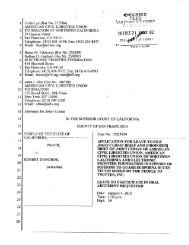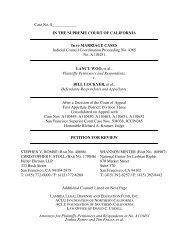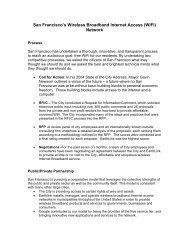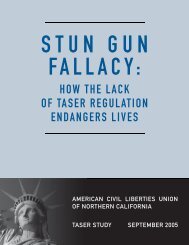Public Safety Realignment - ACLU of Northern California
Public Safety Realignment - ACLU of Northern California
Public Safety Realignment - ACLU of Northern California
- No tags were found...
You also want an ePaper? Increase the reach of your titles
YUMPU automatically turns print PDFs into web optimized ePapers that Google loves.
<strong>of</strong> Counties (CSAC). Because county cooperation was essential to making realignment work, thestate government placed a premium upon leaving the counties considerable flexibility and autonomyin deciding how to allocate the funding and implement realignment. While it makes sense for thestate to consult with CSAC to determine the realignment funding formula, the legislature andgovernor are ultimately responsible to taxpayers and should modify the funding formula to maximizepublic safety return for taxpayer investment. It appears overly optimistic <strong>of</strong> the legislature andadministration to assume that counties will adopt meaningful criminal justice reforms on their ownwithout any state mandates, incentivizes, or oversight. The incarceration habit is deeply engrainedand the politics and practice <strong>of</strong> change across multiple local agencies are difficult.SENTENCING REFORM AND COUNTY FLEXIBILITYBeyond data collection, outcome measurements and funding incentives, there is yet anotherfundamental way in which the state can improve the counties’ ability to successfullyimplement realignment: sentencing reform. For far too long, <strong>California</strong> has locked up toomany people with excessive sentences for low-level <strong>of</strong>fenses. Rolling back draconian penalties forlow-level <strong>of</strong>fenses is essential to provide counties the flexibility to manage their local criminal justicepopulations.A primary example is reducing drug possession crimes to misdemeanors. As this report was going toprint, State Senator Mark Leno (D-San Francisco) had introduced Senate Bill 1506, which wouldrevise the penalty for possession <strong>of</strong> a controlled substance for personal use from a felony, which ispunishable by up to three years behind bars, to a misdemeanor, which is punishable by up to a oneyearjail sentence. This common sense reform would bring <strong>California</strong> into line with the federalgovernment, the District <strong>of</strong> Columbia, and 13 other states that already punish these <strong>of</strong>fenses asmisdemeanors. The new legislation would help alleviate overcrowding in state prisons and countyjails and ease pressure on <strong>California</strong>’s court system. The Legislative Analyst’s Office (LAO)estimates this single sentencing reform willsave counties about $159 million annually, inaddition to $64.4 million in yearly savings forthe state. 40Senator Leno has pointed out that, “There is noevidence to suggest that long prison sentencesdeter or limit people from abusing drugs. Infact, time behind bars and felony records <strong>of</strong>tenhave horrible unintended consequences forpeople trying to overcome addiction becausethey are unlikely to receive drug treatment inprison and have few job prospects and14



